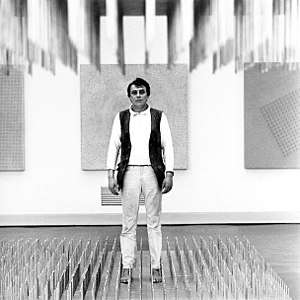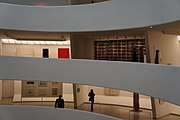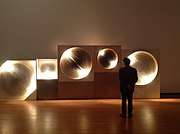Zero (art)
Zero (often styled as ZERO) was an artist group founded in Düsseldorf by Heinz Mack and Otto Piene. Piene described it as "a zone of silence and of pure possibilities for a new beginning."[1] In 1961 Günther Uecker joined the group. ZERO, zero written with capitals, stands for the international movement, with artists from Germany, the Netherlands, Belgium, France, Switzerland, and Italy.



History
Mack, Piene, and Günther Uecker began the ZERO movement.[2] Participants hailed from France (Arman, Jean Tinguely, Yves Klein, and Bernard Aubertin), Italy (Lucio Fontana, Piero Manzoni, Belgium (Pol Bury), and Switzerland (Christian Megert).[3]
Many of the ZERO artists are better known for their affiliations with other movements, including Nouveau réalisme, Arte Povera, Minimalism, Op Art, Land Art, and Kinetic art.[4]
Exhibitions


Early shows
In 1959, artists Pol Bury, Paul van Hoeydonck, Jean Tinguely, and Daniel Spoerri organized Motion in Vision – Vision in Motion, an exhibition at Hessenhuis in Antwerp that for the first time gave ZERO an international audience. This show was the first major ZERO exhibition, after previous shows held at their studio by Heinz Mack and Piene in 1957.
In the early 1960s, the artist Henk Peeters presented the international director of the Stedelijk Museum Amsterdam, Willem Sandberg, with monochromatic works of the young European artists' generation. In a close exchange with Mack, Piene, and Günther Uecker, as well as Yves Klein and Piero Manzoni, the original concept was further developed. This was the result of a 1962 exhibition which, besides monochromy, also concerned itself with color, vibration, light, and movement. There were works by European artists, works from North and South America, as well as from Japan. The exhibition was initiated, organized, and financed by the artists themselves. The selection of the participants took place likewise by the artists, without curatorial assistance. The exhibition was accompanied by a jointly developed catalog.
Retrospective shows
Between 1993 and 1999, four ZERO exhibitions took place at Galerie Villa Merkel in Esslingen, curated by art historian Renate Wiehager. The exhibition series, which was specific to the NUL Group from the Netherlands, ZERO Italy, and ZERO Paris, was ended in 1999 with the exhibition Zero Deutschland 1960. Apart from the three protagonists of the German ZERO movement, Weihager devoted herself to a further twenty artists whose works ranged from the late 1950s to the 1990s. Unlike in the 1960s, this series of exhibitions was not initiated, organized and financed by the artists. A series of four publications was issued, with a first comprehensive overview of ZERO as a European movement in four languages: German, English, Dutch, and French.
The Museum Kunstpalast in Düsseldorf presented the first overview exhibition of the international ZERO avant-garde in 2006. The exhibition, organized and curated by Jean-Hubert Martin and Mattijs Visser, exhibited paintings and installations by country. Mack, Piene, and Uecker curated their own areas. Henk Peeters, who had organized the historical ZERO exhibitions in 1962 and 1965 at the Stedelijk Museum Amsterdam, consulted in the field of design, selection of artists and works. The Düsseldorf exhibition covered several aspects of the exhibitions from the Stedelijk Museum Amsterdam in the form of reconstructions of former installations.
In 2006, the Museum der Moderne Salzburg presented 120 works by 50 Zero artists.[5] The works were loaned by the German collectors Gerhard and Anna Lenz, a German couple that was involved with the Zero movement almost from its beginnings.[3] Gerhard Lenz had first encountered the Zero group at an exhibition of Piene’s work in a Düsseldorf bookshop more in 1963. From 1974, the couple exhibited the collection in 12 shows over 25 years, including in Frankfurt, Barcelona, Moscow, and Warsaw.[6]
In 2013, the Museu Oscar Niemeyer, Curitiba, Brazil showcased Zero, the largest exhibition ever held in Brazil featuring this group present works by key artists of the movement, alongside Latin American artists such as Hércules Barzotti, Lygia Clark and Abraham Palatnik from Brazil, Gertrud Goldschmidt (GEGO) from Venezuela, and Gyula Kosice from Argentina, all of whom used the same visual languages than the original members in the same time period. This venue traveled to Iberê Camargo Foundation at Porto Alegre, RS, Brazil, and finally was shown in 2014 on Pinacoteca do Estado de São Paulo at São Paulo, Brazil.[7]
The exhibition at the Neuberger Museum of Art in 2013 included works from the museum's permanent collection, by artists who were part of or exhibited with Group Zero, including Getulio Alviani, Hartmut Böhm, Enrico Castellani, Gianni Colombo, Lucio Fontana, Heinz Mack, Almir Mavignier, Henk Peeters, Otto Piene, Jesús Rafael Soto, Jean Tinguely, Luis Tomasello, and Günther Uecker.[8]
The Solomon R. Guggenheim Museum showcased the group’s work in ZERO: Countdown to Tomorrow, 1950s-60s, an exhibition that featured more than 40 artists from over 10 countries.[9] This was the first large-scale historical survey of the group's work in the United States. The exhibition was initiated by the ZERO foundation and toured 2015-16 to the Martin-Gropius-Bau in Berlin and the Stedelijk Museum in Amsterdam.
An exhibition opened in March 2015 at the Martin-Gropius-Bau Berlin, conceived and organized jointly by artists and experts in the tradition of the ZERO movement. Various subjects – articulated in time, space, color, reflection, vibration, light, and movement – showed works of art from the central years of the ZERO movement from 1957 to 1967. With around 40 artists, the exhibition followed the ZERO spirit, from two-dimensional paintings to the three-dimensional space. On a total of 3,000 square meters, artists from Germany, Italy, France, Belgium, the Netherlands, Venezuela, Switzerland, Japan, the US, and Brazil were represented with around 200 works and ten space-filling installations. Among them were some rare works from renowned collections such as the Georges Pompidou Center, the Morsbroich Museum, the Stedelijk Museum in Amsterdam, and the Museum of Fine Arts in Düsseldorf. In addition, for the first time, works by several artists were shown: Manzoni, Verheyen, Fontana, Tinguely, Klein, Mack, and Piene. The highlight of the collaboration was the space-saving historical installation Lichtraum (Hommage à Fontana) by Mack, Piene, and Uecker, which was presented for the first time at the documenta III 1964. Heinz Mack presented an installation as an homage to his already deceased ZERO friends. In the form of a ZERO chronology, the most important exhibitions and events were documented using previously unpublished photo and video material. In addition, the works that had previously been lost in the course of the preparation of the exhibition were still to be seen in this exhibition.
An exhibition titled ZERO: Countdown to the Future was on display at the Multimedia Museum in Moscow, and in Sakıp Sabancı Museum in Istanbul, Turkey in 2015.[10]
In 2018, the Museum of Old and New Art in Hobart Tasmania organized a large show around the theme of "Vibration", with historical old and reconstructed installations, the first time that ZERO shows on the other side of the world. The exhibition included large installations by Enrico Castellani, Gianni Colombo, Heinz Mack, Henk Peeters, Otto Piene, Jesús Rafael Soto, Jean Tinguely, and Günther Uecker. A separate section was, for the first time in a ZERO show, dedicated to "father figures" of the movement: Victor Vasarely, Marcel Duchamp, and Lucio Fontana. [11]
ZERO Foundation
The ZERO Foundation is a German cultural institute, established in December 2008, with support of Düsseldorf-based ZERO artists, Heinz Mack, Otto Piene and Günther Uecker, and Museum Kunst Palast. It is funded by the state capital Düsseldorf. The artists donated works as well as their archives from the ZERO period comprising photographs, correspondence, invitation cards, newspaper clippings and other documents. The initiative behind the foundation was taken by Mattijs Visser, who led it from 2009-2017.[12] [13][14][15][16]
- Organisation
- Staff: Dr. Barbara Könches, director; Dr. Tiziana Caianiello, Katrin Lohe, Laura Weber, Thekla Zell.
- Board of Directors: Dr. Friderike Bagel, Claus Gielisch, Dr. Felix Krämer, Harry Schmitz, Professor Dr. Jürgen Wilhelm.
Background
The foundation has important works mainly from Heinz Mack, Otto Piene, Günther Uecker, and other artists from the ZERO movement.
The ZERO foundation was established in 2008 by the Düsseldorf ZERO artists Heinz Mack, Otto Piene, and Günther Uecker together with the Museum Kunstpalast. Its founding mission was to preserve, present, study, and support the work of the international ZERO movement.
For this purpose, the artists donated numerous works and their archives from the ZERO period, including important documents such as photographs, correspondence, posters, invitations, press articles, and magazines. Over the last few years additional works and documents of the international ZERO avantgarde have been collected and made available to the public and international scholars through the development of exhibition projects and publications. These efforts are not only focused on the ZERO period itself (1958-1966) but also on the continuing impact of ZERO into present. The archive and library of the ZERO foundation are available for research purposes.
A unique aspect of the ZERO foundation is that the living artists are actively involved in the work of the organization. First-hand information about the ZERO period can be passed on and integrated into scholarship on the movement.
Other research
Visser went on to found the 0-Institute,[17] focused on presenting the works and documents of international artists associated with the ZERO movement in a contemporary context.
Art market
In 2010, Sotheby's auctioned off part the collection of Gerhard and Anna Lenz in London. Initially valued at 12 million pounds ($19.5 million),[6] the 49 paintings, drawings and low-relief panels made up from a variety of media were sold in an evening auction reaching £54.07 million, or about $84.5 million; unusual for a contemporary art sale, 74 of the 77 lots offered sold, resulting in a 96 percent success rate.[18][19][20][21]
References
- Karen Rosenberg (August 21, 2014), Hail, the Postwar Avant-Garde: ‘The Art of Zero,’ at Purchase College New York Times.
- ZERO in New York, 6 November - 20 December 2008 Archived April 16, 2012, at the Wayback Machine Sperone Westwater, New York.
- David Galloway (March 3, 2006), European movement with Zero as the sum of its parts International Herald Tribune.
- Roberta Smith (October 9, 2014), 3 Men and a Posse, Chasing Newness: ‘Zero,’ a Look at a Movement, at the Guggenheim New York Times.
- Mariana Schroeder (May 19, 2006),Gauging the Impact of Zero Wall Street Journal.
- Catherine Hickley (January 20, 2010), Klein, Fontana Collectors Lenz to Auction $19.5 Million of Art Bloomberg.
- "ZERO" – exhibition catalog of the most important travelling exhibition in America of Zero Group, edited by Heike van der Valentyn, with essays by Otto, Piene, Paulo Venencio Filho, Heinz-Norbert Jocks, Heike van den Valentyn, published by Museu Oscar Niemeyer, Iberê Camargo Foundation & Pinacoteca do Estado de São Paulo and printed in São Paulo, Brazil, 2013, ISBN 978-85-60638-37-6
- The Art of Zero Neuberger Museum of Art, Purchase, NY.
- "Guggenheim". The Solomon R. Guggenheim Foundation (SRGF). Retrieved 4 August 2015.
- "ZERO. Countdown to the Future". Retrieved 19 March 2016.
- Museum of Old and New Art
- Maine, Stephen (2009-06-16). "Zero & Friends". ARTnews.com. Retrieved 2020-02-20.
- "First Look: 'ZERO: Countdown to Tomorrow' at the Guggenheim New York". Apollo Magazine. 2014-10-07. Retrieved 2020-02-20.
- "ZERO-Foundation: Umzug". www.kunstforum.de (in German). Retrieved 2020-02-20.
- Goodeve, Thyrza Nichols (2015-07-13). "WHEN ATTITUDE BECOMES A FOUNDATION "Making the Impossible Possible" in North Rhine-Westphalia and—for a Few Days in July—New York City". The Brooklyn Rail. Retrieved 2020-02-20.
- "Hermann Goepfert Biography – Hermann Goepfert on artnet". www.artnet.com. Retrieved 2020-02-20.
- "0 Institute". MENU. Retrieved 2020-05-18.
- Souren Melikian (February 11, 2010), A Great Night for Sotheby’s Contemporary Art Auction International Herald Tribune.
- Souren Melikian (February 12, 2010), An Almost Defiant Success International Herald Tribune.
- Adam Lindemann (December 14, 2010), Why the Art Market Is Rising New York Observer.
- Sarah Thornton (February 17, 2010), Out from the ashes The Economist.
External links
- Zero Foundation website
Further reading
- Renate Buschmann, Stephan von Wiese (eds.): Fotos schreiben Kunstgeschichte. DuMont, Cologne 2007 (Exhibition catalogue for Fotos schreiben Kunstgeschichte, December 8, 2007 bis March 2, 2008, Museum Kunst Palast, Düsseldorf). ISBN 978-3-8321-9058-3
- Anette Kuhn: ZERO. Eine Avantgarde der sechziger Jahre. Propyläen, Frankfurt am Main / Berlin 1991. ISBN 978-3-549-06694-2
- Heinz-Norbert Jocks: Das Ohr am Tatort. Heinz-Norbert Jocks im Gespräch mit Gotthard Graubner, Heinz Mack, Roman Opalka, Otto Piene und Günther Uecker. Hatje Cantz, Ostfildern, 2009, hrsg. von Anna Lenz und Ulrike Honich, ISBN 978-3-7757-2509-5.
- Anna Lenz: The Zero Era. The Lenz Schönberg Collection: Living in Art. Hatje Cantz, Ostfildern 2009. ISBN 978-3-7757-2411-1
- museum kunstpalast (ed.): ZERO – Internationale Künstler-Avantgarde der 50er/60er Jahre. With texts by Bazon Brock, Tiziana Caianiello, Heinz-Norbert Jocks, Catherine Millet, Lóránd Hegyi, Valerie L. Hillings, Heike van den Valentyn, Atsuo Yamamoto, Mattijs Visser. Hatje Cantz, Ostfildern 2006. ISBN 978-3-7757-1747-2
- Otto Piene, “The Development the Group “ZERO””, London: The Times Literary Supplement; September 3, 1964.
- Otto Piene and Heinz Mack: Zero. MIT Press, Cambridge, 1973. ISBN 978-0-262-16041-4
- Karl Ruhrberg (ed.): Zeitzeichen. Stationen Bildender Kunst in Nordrhein-Westfalen. DuMont, Cologne 1989. ISBN 3-7701-2314-X
- Klaus Schrenk (ed.): Aufbrüche. Manifeste, Manifestationen. Positionen in der bildenden Kunst zu Beginn der 60er Jahre in Berlin, Düsseldorf und München. DuMont, Cologne 1984.
- Heiner Stachelhaus: Zero. Heinz Mack, Otto Piene, Günther Uecker. Econ, Düsseldorf 1993, ISBN 978-3-430-18683-4
- Mattijs Visser (ed.): ZERO in NY. ZERO foundation and Sperone Westwater, New York/Düsseldorf/Ghent, 2008. ISBN 978-90-76979-73-1
- Gian Enzo Sperone (ed.): Zero e dintorni. Sent, Switzerland, 2009.
- "ZERO" edited by Heike van der Valentyn, with essays by Otto Piene, Paulo Venencio Filho, Heinz-Norbert Jocks, Heike van den Valentyn, published by Museu Oscar Niemeyer, Iberê Camargo Foundation & Pinacoteca do Estado de São Paulo and printed in São Paulo, Brazil, 2013, ISBN 978-85-60638-37-6